Enterprise Resource Planning System Report: Post-Merger Analysis
VerifiedAdded on 2019/09/22
|29
|6580
|433
Report
AI Summary
This report examines the implementation of an Enterprise Resource Planning (ERP) system for AUSPOST and TOLL following their merger. It proposes an enterprise architecture using the TOGAF framework, detailing phases such as preliminary, architecture vision, business architecture, data architecture, technology architecture, opportunities and solutions, telecommunication architecture, and governance framework. The report explores requirements management, ERP system integration, including supplier and customer integration, and the integration of customer relationship management (CRM) and supplier relationship management (SRM) systems. A business analysis, incorporating SWOT analysis and requirement analysis, provides a comprehensive understanding of the proposed enterprise integration. The analysis also highlights the use of cloud computing for telecommunications and data security, ensuring data safety and disaster recovery capabilities. The report emphasizes the integration of various internal business functions, central databases, and the importance of a single telecommunication provider to streamline operations and enhance business value.

Running Head: ERP SYSTEM
ENTERPRISE RESOURCE PLANNING SYSTEM
[Document subtitle]
ENTERPRISE RESOURCE PLANNING SYSTEM
[Document subtitle]
Paraphrase This Document
Need a fresh take? Get an instant paraphrase of this document with our AI Paraphraser

ERP SYSTEM
Abstract
An enterprise resource planning system is defined as a set of modules of software which allow
the organizations to share the data within the organization with the help of the database and the
tools of management. The main motive is to provide access to data of the organization in order to
develop streamlined processes of the work. Further, the report will help in understanding the
proposed enterprise architecture for the implementation of effective ERP system for the
AUSPOST and TOLL. The TOGAF framework will be shown in the implementation of ERP
system. Then the integration of ERP system will be given. Also, the integration of customers and
suppliers along with the integration of a system of customer relationship management and
supplier relationship management will be shown in the report. Then the business analysis with
the help of SWOT analysis and requirement analysis will help in getting the clear understanding
of the proposed enterprise integration.
1
Abstract
An enterprise resource planning system is defined as a set of modules of software which allow
the organizations to share the data within the organization with the help of the database and the
tools of management. The main motive is to provide access to data of the organization in order to
develop streamlined processes of the work. Further, the report will help in understanding the
proposed enterprise architecture for the implementation of effective ERP system for the
AUSPOST and TOLL. The TOGAF framework will be shown in the implementation of ERP
system. Then the integration of ERP system will be given. Also, the integration of customers and
suppliers along with the integration of a system of customer relationship management and
supplier relationship management will be shown in the report. Then the business analysis with
the help of SWOT analysis and requirement analysis will help in getting the clear understanding
of the proposed enterprise integration.
1

ERP SYSTEM
Contents
Introduction......................................................................................................................................3
Proposed Enterprise Architecture....................................................................................................3
Preliminary phase......................................................................................................................4
Phase A........................................................................................................................................4
Phase B........................................................................................................................................4
Phase D........................................................................................................................................6
Phase E........................................................................................................................................6
Phase F........................................................................................................................................7
Phase G........................................................................................................................................7
Requirements Management......................................................................................................8
ERP Systems, SCM, and CRM......................................................................................................11
ERP System Integration..........................................................................................................11
Suppliers and Customers Integration....................................................................................14
Business Analysis..........................................................................................................................16
SWOT Analysis........................................................................................................................16
Requirement Analysis..............................................................................................................19
Conclusion.....................................................................................................................................24
REFERENCES..............................................................................................................................26
2
Contents
Introduction......................................................................................................................................3
Proposed Enterprise Architecture....................................................................................................3
Preliminary phase......................................................................................................................4
Phase A........................................................................................................................................4
Phase B........................................................................................................................................4
Phase D........................................................................................................................................6
Phase E........................................................................................................................................6
Phase F........................................................................................................................................7
Phase G........................................................................................................................................7
Requirements Management......................................................................................................8
ERP Systems, SCM, and CRM......................................................................................................11
ERP System Integration..........................................................................................................11
Suppliers and Customers Integration....................................................................................14
Business Analysis..........................................................................................................................16
SWOT Analysis........................................................................................................................16
Requirement Analysis..............................................................................................................19
Conclusion.....................................................................................................................................24
REFERENCES..............................................................................................................................26
2
⊘ This is a preview!⊘
Do you want full access?
Subscribe today to unlock all pages.

Trusted by 1+ million students worldwide
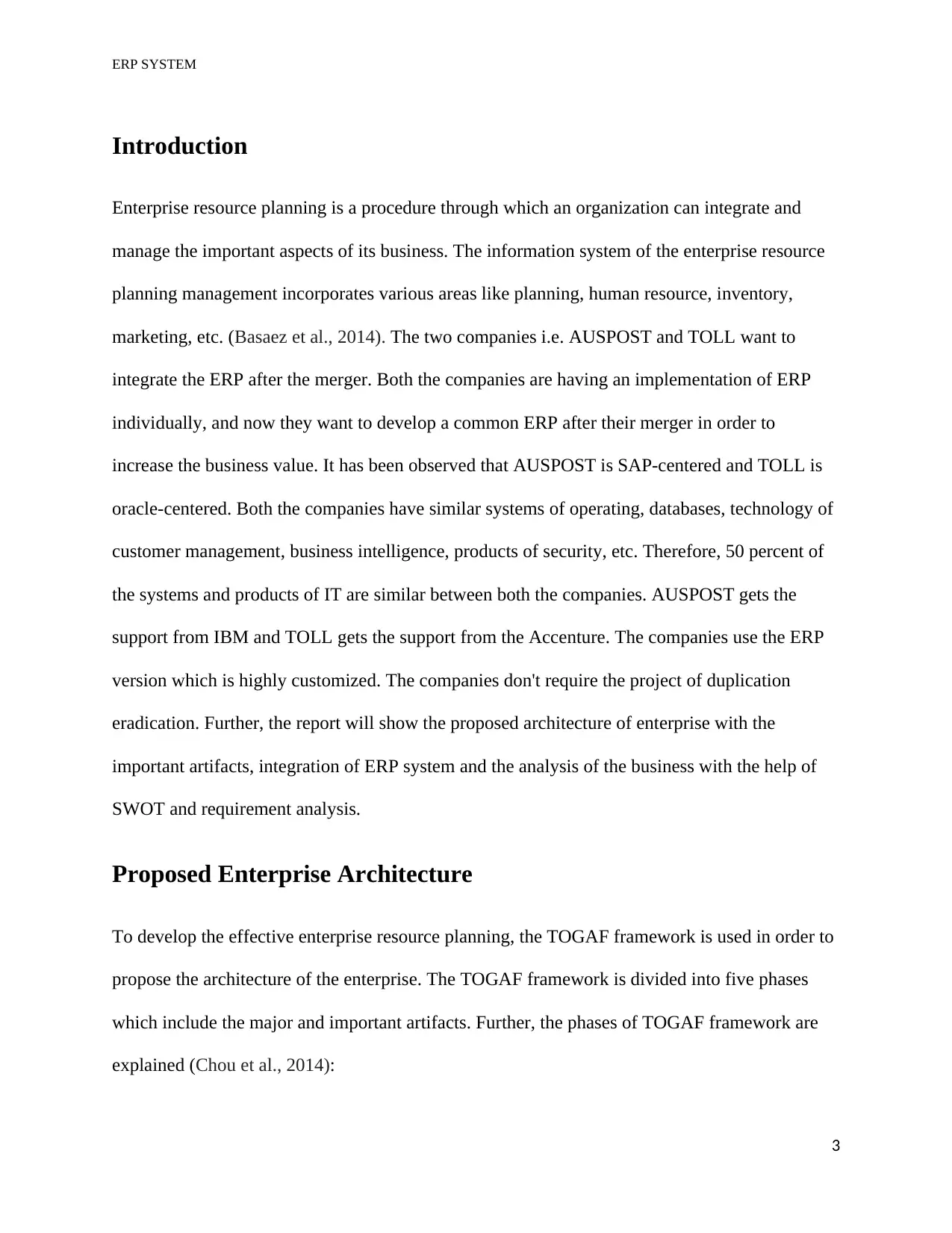
ERP SYSTEM
Introduction
Enterprise resource planning is a procedure through which an organization can integrate and
manage the important aspects of its business. The information system of the enterprise resource
planning management incorporates various areas like planning, human resource, inventory,
marketing, etc. (Basaez et al., 2014). The two companies i.e. AUSPOST and TOLL want to
integrate the ERP after the merger. Both the companies are having an implementation of ERP
individually, and now they want to develop a common ERP after their merger in order to
increase the business value. It has been observed that AUSPOST is SAP-centered and TOLL is
oracle-centered. Both the companies have similar systems of operating, databases, technology of
customer management, business intelligence, products of security, etc. Therefore, 50 percent of
the systems and products of IT are similar between both the companies. AUSPOST gets the
support from IBM and TOLL gets the support from the Accenture. The companies use the ERP
version which is highly customized. The companies don't require the project of duplication
eradication. Further, the report will show the proposed architecture of enterprise with the
important artifacts, integration of ERP system and the analysis of the business with the help of
SWOT and requirement analysis.
Proposed Enterprise Architecture
To develop the effective enterprise resource planning, the TOGAF framework is used in order to
propose the architecture of the enterprise. The TOGAF framework is divided into five phases
which include the major and important artifacts. Further, the phases of TOGAF framework are
explained (Chou et al., 2014):
3
Introduction
Enterprise resource planning is a procedure through which an organization can integrate and
manage the important aspects of its business. The information system of the enterprise resource
planning management incorporates various areas like planning, human resource, inventory,
marketing, etc. (Basaez et al., 2014). The two companies i.e. AUSPOST and TOLL want to
integrate the ERP after the merger. Both the companies are having an implementation of ERP
individually, and now they want to develop a common ERP after their merger in order to
increase the business value. It has been observed that AUSPOST is SAP-centered and TOLL is
oracle-centered. Both the companies have similar systems of operating, databases, technology of
customer management, business intelligence, products of security, etc. Therefore, 50 percent of
the systems and products of IT are similar between both the companies. AUSPOST gets the
support from IBM and TOLL gets the support from the Accenture. The companies use the ERP
version which is highly customized. The companies don't require the project of duplication
eradication. Further, the report will show the proposed architecture of enterprise with the
important artifacts, integration of ERP system and the analysis of the business with the help of
SWOT and requirement analysis.
Proposed Enterprise Architecture
To develop the effective enterprise resource planning, the TOGAF framework is used in order to
propose the architecture of the enterprise. The TOGAF framework is divided into five phases
which include the major and important artifacts. Further, the phases of TOGAF framework are
explained (Chou et al., 2014):
3
Paraphrase This Document
Need a fresh take? Get an instant paraphrase of this document with our AI Paraphraser
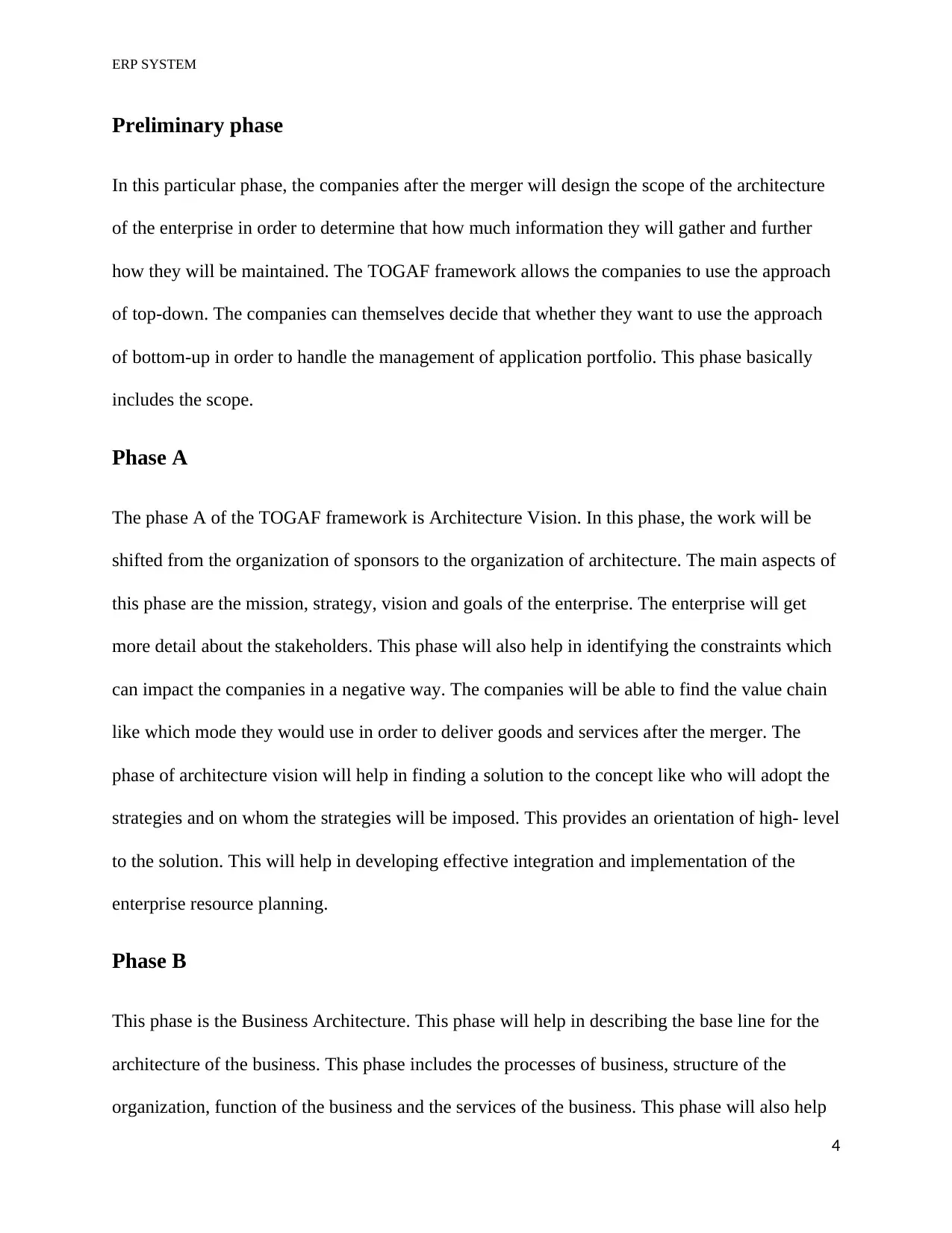
ERP SYSTEM
Preliminary phase
In this particular phase, the companies after the merger will design the scope of the architecture
of the enterprise in order to determine that how much information they will gather and further
how they will be maintained. The TOGAF framework allows the companies to use the approach
of top-down. The companies can themselves decide that whether they want to use the approach
of bottom-up in order to handle the management of application portfolio. This phase basically
includes the scope.
Phase A
The phase A of the TOGAF framework is Architecture Vision. In this phase, the work will be
shifted from the organization of sponsors to the organization of architecture. The main aspects of
this phase are the mission, strategy, vision and goals of the enterprise. The enterprise will get
more detail about the stakeholders. This phase will also help in identifying the constraints which
can impact the companies in a negative way. The companies will be able to find the value chain
like which mode they would use in order to deliver goods and services after the merger. The
phase of architecture vision will help in finding a solution to the concept like who will adopt the
strategies and on whom the strategies will be imposed. This provides an orientation of high- level
to the solution. This will help in developing effective integration and implementation of the
enterprise resource planning.
Phase B
This phase is the Business Architecture. This phase will help in describing the base line for the
architecture of the business. This phase includes the processes of business, structure of the
organization, function of the business and the services of the business. This phase will also help
4
Preliminary phase
In this particular phase, the companies after the merger will design the scope of the architecture
of the enterprise in order to determine that how much information they will gather and further
how they will be maintained. The TOGAF framework allows the companies to use the approach
of top-down. The companies can themselves decide that whether they want to use the approach
of bottom-up in order to handle the management of application portfolio. This phase basically
includes the scope.
Phase A
The phase A of the TOGAF framework is Architecture Vision. In this phase, the work will be
shifted from the organization of sponsors to the organization of architecture. The main aspects of
this phase are the mission, strategy, vision and goals of the enterprise. The enterprise will get
more detail about the stakeholders. This phase will also help in identifying the constraints which
can impact the companies in a negative way. The companies will be able to find the value chain
like which mode they would use in order to deliver goods and services after the merger. The
phase of architecture vision will help in finding a solution to the concept like who will adopt the
strategies and on whom the strategies will be imposed. This provides an orientation of high- level
to the solution. This will help in developing effective integration and implementation of the
enterprise resource planning.
Phase B
This phase is the Business Architecture. This phase will help in describing the base line for the
architecture of the business. This phase includes the processes of business, structure of the
organization, function of the business and the services of the business. This phase will also help
4
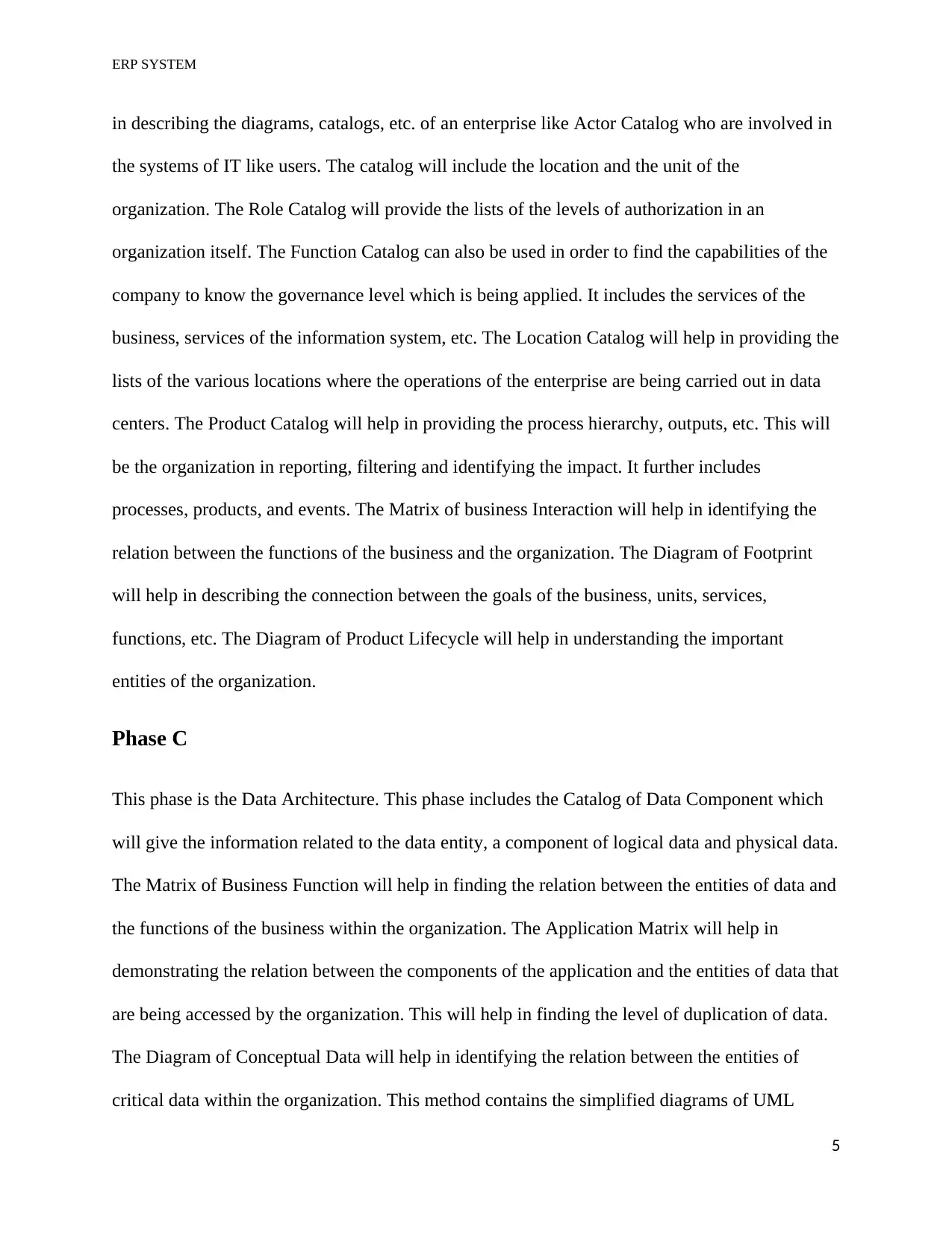
ERP SYSTEM
in describing the diagrams, catalogs, etc. of an enterprise like Actor Catalog who are involved in
the systems of IT like users. The catalog will include the location and the unit of the
organization. The Role Catalog will provide the lists of the levels of authorization in an
organization itself. The Function Catalog can also be used in order to find the capabilities of the
company to know the governance level which is being applied. It includes the services of the
business, services of the information system, etc. The Location Catalog will help in providing the
lists of the various locations where the operations of the enterprise are being carried out in data
centers. The Product Catalog will help in providing the process hierarchy, outputs, etc. This will
be the organization in reporting, filtering and identifying the impact. It further includes
processes, products, and events. The Matrix of business Interaction will help in identifying the
relation between the functions of the business and the organization. The Diagram of Footprint
will help in describing the connection between the goals of the business, units, services,
functions, etc. The Diagram of Product Lifecycle will help in understanding the important
entities of the organization.
Phase C
This phase is the Data Architecture. This phase includes the Catalog of Data Component which
will give the information related to the data entity, a component of logical data and physical data.
The Matrix of Business Function will help in finding the relation between the entities of data and
the functions of the business within the organization. The Application Matrix will help in
demonstrating the relation between the components of the application and the entities of data that
are being accessed by the organization. This will help in finding the level of duplication of data.
The Diagram of Conceptual Data will help in identifying the relation between the entities of
critical data within the organization. This method contains the simplified diagrams of UML
5
in describing the diagrams, catalogs, etc. of an enterprise like Actor Catalog who are involved in
the systems of IT like users. The catalog will include the location and the unit of the
organization. The Role Catalog will provide the lists of the levels of authorization in an
organization itself. The Function Catalog can also be used in order to find the capabilities of the
company to know the governance level which is being applied. It includes the services of the
business, services of the information system, etc. The Location Catalog will help in providing the
lists of the various locations where the operations of the enterprise are being carried out in data
centers. The Product Catalog will help in providing the process hierarchy, outputs, etc. This will
be the organization in reporting, filtering and identifying the impact. It further includes
processes, products, and events. The Matrix of business Interaction will help in identifying the
relation between the functions of the business and the organization. The Diagram of Footprint
will help in describing the connection between the goals of the business, units, services,
functions, etc. The Diagram of Product Lifecycle will help in understanding the important
entities of the organization.
Phase C
This phase is the Data Architecture. This phase includes the Catalog of Data Component which
will give the information related to the data entity, a component of logical data and physical data.
The Matrix of Business Function will help in finding the relation between the entities of data and
the functions of the business within the organization. The Application Matrix will help in
demonstrating the relation between the components of the application and the entities of data that
are being accessed by the organization. This will help in finding the level of duplication of data.
The Diagram of Conceptual Data will help in identifying the relation between the entities of
critical data within the organization. This method contains the simplified diagrams of UML
5
⊘ This is a preview!⊘
Do you want full access?
Subscribe today to unlock all pages.

Trusted by 1+ million students worldwide
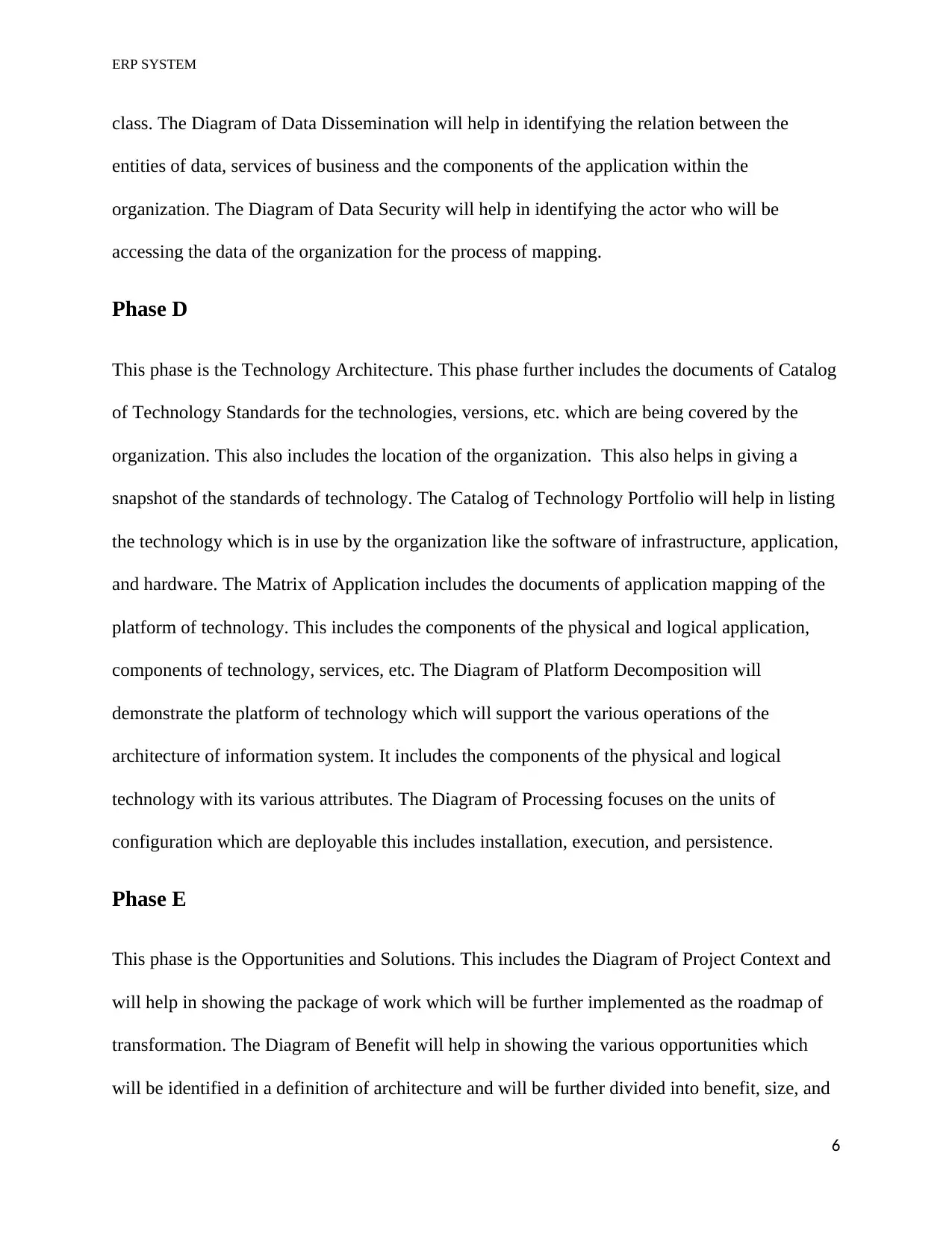
ERP SYSTEM
class. The Diagram of Data Dissemination will help in identifying the relation between the
entities of data, services of business and the components of the application within the
organization. The Diagram of Data Security will help in identifying the actor who will be
accessing the data of the organization for the process of mapping.
Phase D
This phase is the Technology Architecture. This phase further includes the documents of Catalog
of Technology Standards for the technologies, versions, etc. which are being covered by the
organization. This also includes the location of the organization. This also helps in giving a
snapshot of the standards of technology. The Catalog of Technology Portfolio will help in listing
the technology which is in use by the organization like the software of infrastructure, application,
and hardware. The Matrix of Application includes the documents of application mapping of the
platform of technology. This includes the components of the physical and logical application,
components of technology, services, etc. The Diagram of Platform Decomposition will
demonstrate the platform of technology which will support the various operations of the
architecture of information system. It includes the components of the physical and logical
technology with its various attributes. The Diagram of Processing focuses on the units of
configuration which are deployable this includes installation, execution, and persistence.
Phase E
This phase is the Opportunities and Solutions. This includes the Diagram of Project Context and
will help in showing the package of work which will be further implemented as the roadmap of
transformation. The Diagram of Benefit will help in showing the various opportunities which
will be identified in a definition of architecture and will be further divided into benefit, size, and
6
class. The Diagram of Data Dissemination will help in identifying the relation between the
entities of data, services of business and the components of the application within the
organization. The Diagram of Data Security will help in identifying the actor who will be
accessing the data of the organization for the process of mapping.
Phase D
This phase is the Technology Architecture. This phase further includes the documents of Catalog
of Technology Standards for the technologies, versions, etc. which are being covered by the
organization. This also includes the location of the organization. This also helps in giving a
snapshot of the standards of technology. The Catalog of Technology Portfolio will help in listing
the technology which is in use by the organization like the software of infrastructure, application,
and hardware. The Matrix of Application includes the documents of application mapping of the
platform of technology. This includes the components of the physical and logical application,
components of technology, services, etc. The Diagram of Platform Decomposition will
demonstrate the platform of technology which will support the various operations of the
architecture of information system. It includes the components of the physical and logical
technology with its various attributes. The Diagram of Processing focuses on the units of
configuration which are deployable this includes installation, execution, and persistence.
Phase E
This phase is the Opportunities and Solutions. This includes the Diagram of Project Context and
will help in showing the package of work which will be further implemented as the roadmap of
transformation. The Diagram of Benefit will help in showing the various opportunities which
will be identified in a definition of architecture and will be further divided into benefit, size, and
6
Paraphrase This Document
Need a fresh take? Get an instant paraphrase of this document with our AI Paraphraser
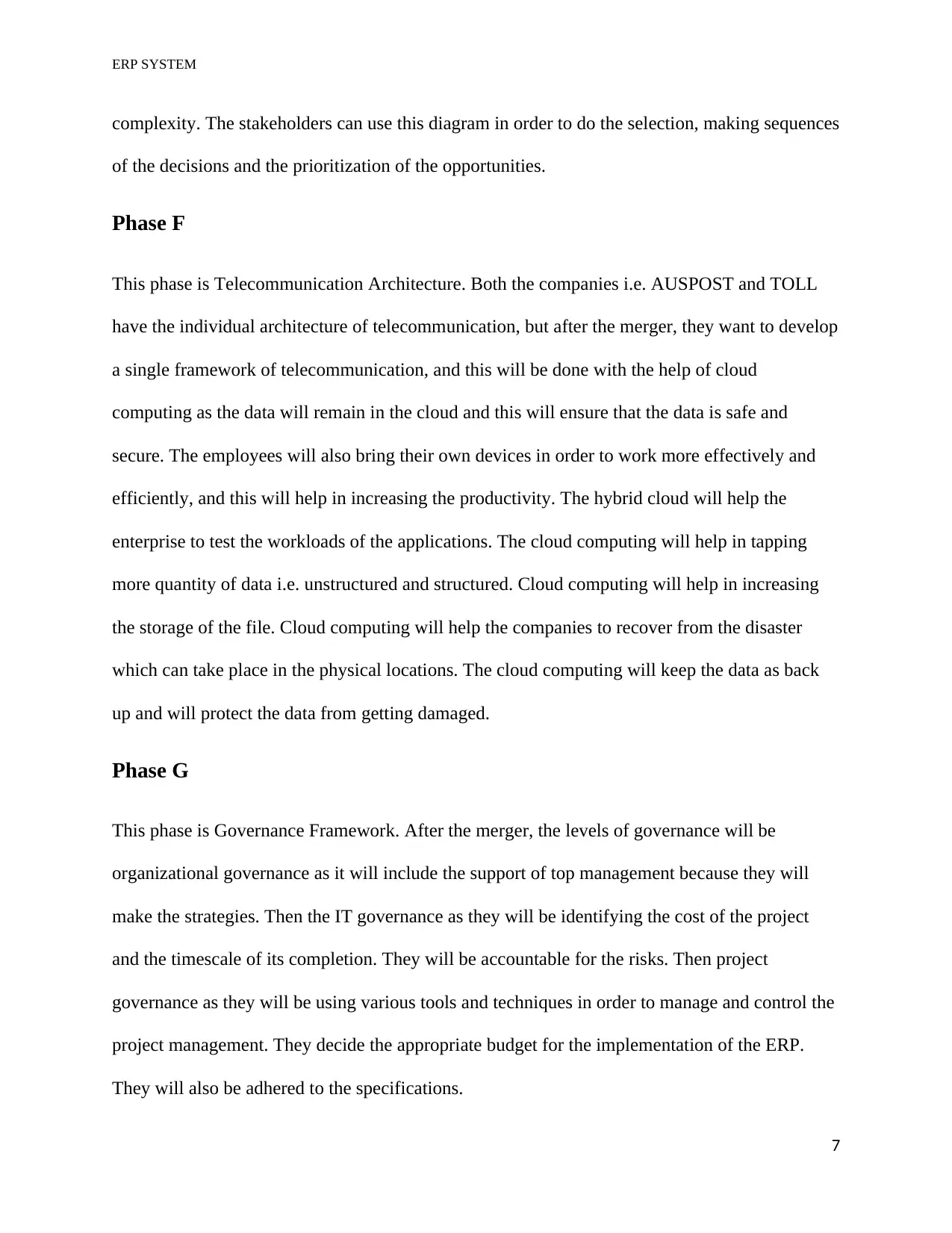
ERP SYSTEM
complexity. The stakeholders can use this diagram in order to do the selection, making sequences
of the decisions and the prioritization of the opportunities.
Phase F
This phase is Telecommunication Architecture. Both the companies i.e. AUSPOST and TOLL
have the individual architecture of telecommunication, but after the merger, they want to develop
a single framework of telecommunication, and this will be done with the help of cloud
computing as the data will remain in the cloud and this will ensure that the data is safe and
secure. The employees will also bring their own devices in order to work more effectively and
efficiently, and this will help in increasing the productivity. The hybrid cloud will help the
enterprise to test the workloads of the applications. The cloud computing will help in tapping
more quantity of data i.e. unstructured and structured. Cloud computing will help in increasing
the storage of the file. Cloud computing will help the companies to recover from the disaster
which can take place in the physical locations. The cloud computing will keep the data as back
up and will protect the data from getting damaged.
Phase G
This phase is Governance Framework. After the merger, the levels of governance will be
organizational governance as it will include the support of top management because they will
make the strategies. Then the IT governance as they will be identifying the cost of the project
and the timescale of its completion. They will be accountable for the risks. Then project
governance as they will be using various tools and techniques in order to manage and control the
project management. They decide the appropriate budget for the implementation of the ERP.
They will also be adhered to the specifications.
7
complexity. The stakeholders can use this diagram in order to do the selection, making sequences
of the decisions and the prioritization of the opportunities.
Phase F
This phase is Telecommunication Architecture. Both the companies i.e. AUSPOST and TOLL
have the individual architecture of telecommunication, but after the merger, they want to develop
a single framework of telecommunication, and this will be done with the help of cloud
computing as the data will remain in the cloud and this will ensure that the data is safe and
secure. The employees will also bring their own devices in order to work more effectively and
efficiently, and this will help in increasing the productivity. The hybrid cloud will help the
enterprise to test the workloads of the applications. The cloud computing will help in tapping
more quantity of data i.e. unstructured and structured. Cloud computing will help in increasing
the storage of the file. Cloud computing will help the companies to recover from the disaster
which can take place in the physical locations. The cloud computing will keep the data as back
up and will protect the data from getting damaged.
Phase G
This phase is Governance Framework. After the merger, the levels of governance will be
organizational governance as it will include the support of top management because they will
make the strategies. Then the IT governance as they will be identifying the cost of the project
and the timescale of its completion. They will be accountable for the risks. Then project
governance as they will be using various tools and techniques in order to manage and control the
project management. They decide the appropriate budget for the implementation of the ERP.
They will also be adhered to the specifications.
7

ERP SYSTEM
Requirements Management
This phase includes the Catalog of the Requirements which will captive the things that will be
required by the organizations in order to meet their desired common objectives. The
requirements can be used as a tool for quality assurance in order to make sure that the required
architecture of framework is suitable for this purpose or not. The catalog of requirements
includes assumption, constraint, and gap (Hassab Elnaby et al., 2012).
Therefore, TOGAF framework will help in developing the effective system of enterprise
resource planning and EAI. The effective telecommunication can be created with the help of
cloud computing as it will provide the quality assurance and will also have the facility to recover
to data from disaster and it will also be very useful for the data marts which will be integrated
and the warehouse which will be off-site. The software security architecture will be made in
order to secure the data and information of the stakeholders.
8
Requirements Management
This phase includes the Catalog of the Requirements which will captive the things that will be
required by the organizations in order to meet their desired common objectives. The
requirements can be used as a tool for quality assurance in order to make sure that the required
architecture of framework is suitable for this purpose or not. The catalog of requirements
includes assumption, constraint, and gap (Hassab Elnaby et al., 2012).
Therefore, TOGAF framework will help in developing the effective system of enterprise
resource planning and EAI. The effective telecommunication can be created with the help of
cloud computing as it will provide the quality assurance and will also have the facility to recover
to data from disaster and it will also be very useful for the data marts which will be integrated
and the warehouse which will be off-site. The software security architecture will be made in
order to secure the data and information of the stakeholders.
8
⊘ This is a preview!⊘
Do you want full access?
Subscribe today to unlock all pages.

Trusted by 1+ million students worldwide

ERP SYSTEM
The enterprise resource planning system and the enterprise application integration will help the
companies in concentrating, rationalizing and refreshing the organized internal systems of the
business after the merger. As the diagram shows that the enterprise resource planning will be
handling the internal functions like financial applications, manufacturing applications and
inventory management which the company will get from the supplier and the services, sales and
distribution which will be given and managed at the end of the customers. The single
telecommunication provider is being developed for both the companies after the merger, as the
cloud computing will be used in order maintain and secure the data of the customers. The central
database will be connected to the system of enterprise resource planning in order to give the
solution for the management of call center to the customers with the help of partners; the call
center management is not directly connected with the system of enterprise resource planning. As
it can be seen in the diagram, the central database will also provide the facility for the disaster
recovery in order to use the off-site data warehouse with the integration of data marts which will
protect the important information and data of the customers from the disaster.
9
The enterprise resource planning system and the enterprise application integration will help the
companies in concentrating, rationalizing and refreshing the organized internal systems of the
business after the merger. As the diagram shows that the enterprise resource planning will be
handling the internal functions like financial applications, manufacturing applications and
inventory management which the company will get from the supplier and the services, sales and
distribution which will be given and managed at the end of the customers. The single
telecommunication provider is being developed for both the companies after the merger, as the
cloud computing will be used in order maintain and secure the data of the customers. The central
database will be connected to the system of enterprise resource planning in order to give the
solution for the management of call center to the customers with the help of partners; the call
center management is not directly connected with the system of enterprise resource planning. As
it can be seen in the diagram, the central database will also provide the facility for the disaster
recovery in order to use the off-site data warehouse with the integration of data marts which will
protect the important information and data of the customers from the disaster.
9
Paraphrase This Document
Need a fresh take? Get an instant paraphrase of this document with our AI Paraphraser
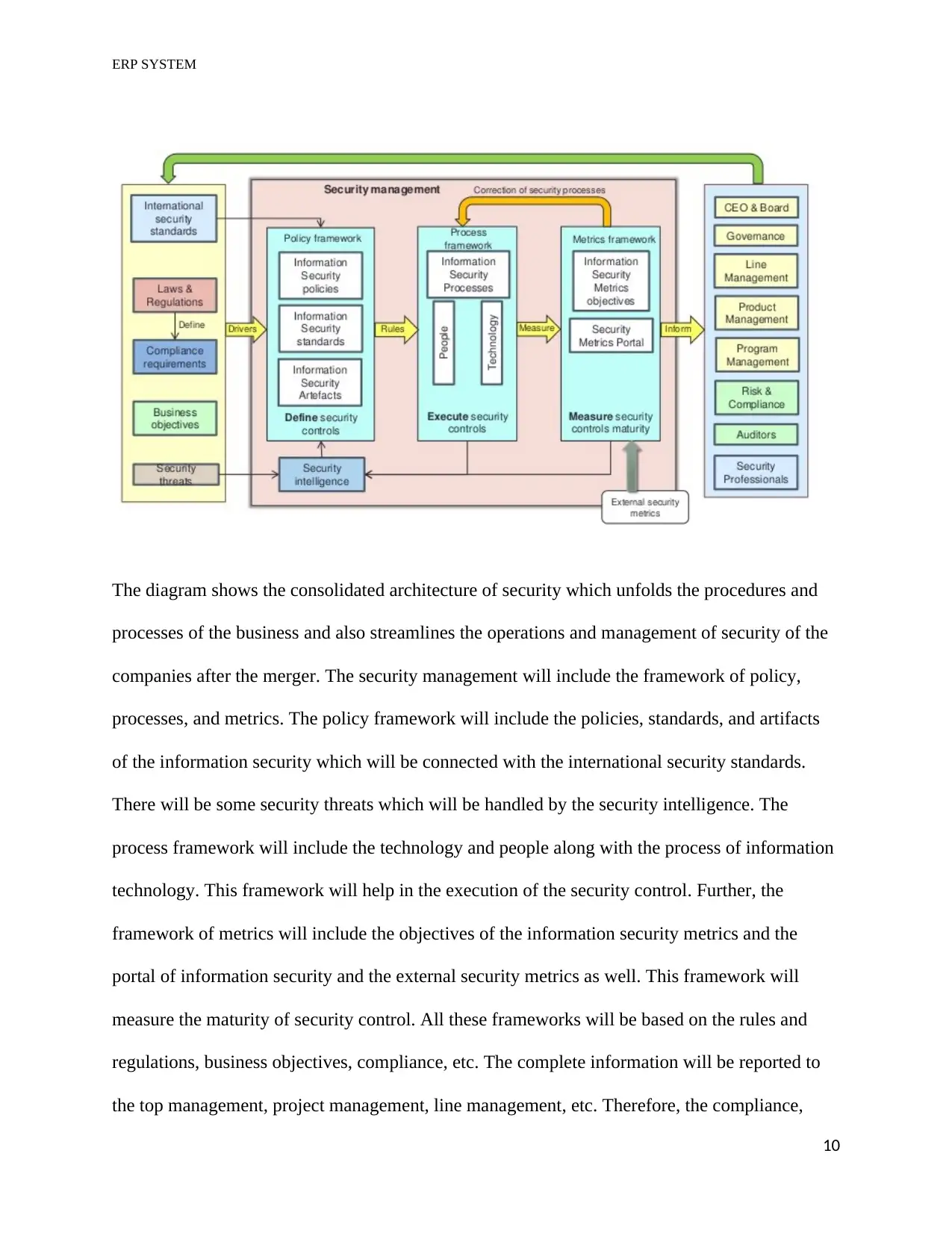
ERP SYSTEM
The diagram shows the consolidated architecture of security which unfolds the procedures and
processes of the business and also streamlines the operations and management of security of the
companies after the merger. The security management will include the framework of policy,
processes, and metrics. The policy framework will include the policies, standards, and artifacts
of the information security which will be connected with the international security standards.
There will be some security threats which will be handled by the security intelligence. The
process framework will include the technology and people along with the process of information
technology. This framework will help in the execution of the security control. Further, the
framework of metrics will include the objectives of the information security metrics and the
portal of information security and the external security metrics as well. This framework will
measure the maturity of security control. All these frameworks will be based on the rules and
regulations, business objectives, compliance, etc. The complete information will be reported to
the top management, project management, line management, etc. Therefore, the compliance,
10
The diagram shows the consolidated architecture of security which unfolds the procedures and
processes of the business and also streamlines the operations and management of security of the
companies after the merger. The security management will include the framework of policy,
processes, and metrics. The policy framework will include the policies, standards, and artifacts
of the information security which will be connected with the international security standards.
There will be some security threats which will be handled by the security intelligence. The
process framework will include the technology and people along with the process of information
technology. This framework will help in the execution of the security control. Further, the
framework of metrics will include the objectives of the information security metrics and the
portal of information security and the external security metrics as well. This framework will
measure the maturity of security control. All these frameworks will be based on the rules and
regulations, business objectives, compliance, etc. The complete information will be reported to
the top management, project management, line management, etc. Therefore, the compliance,
10
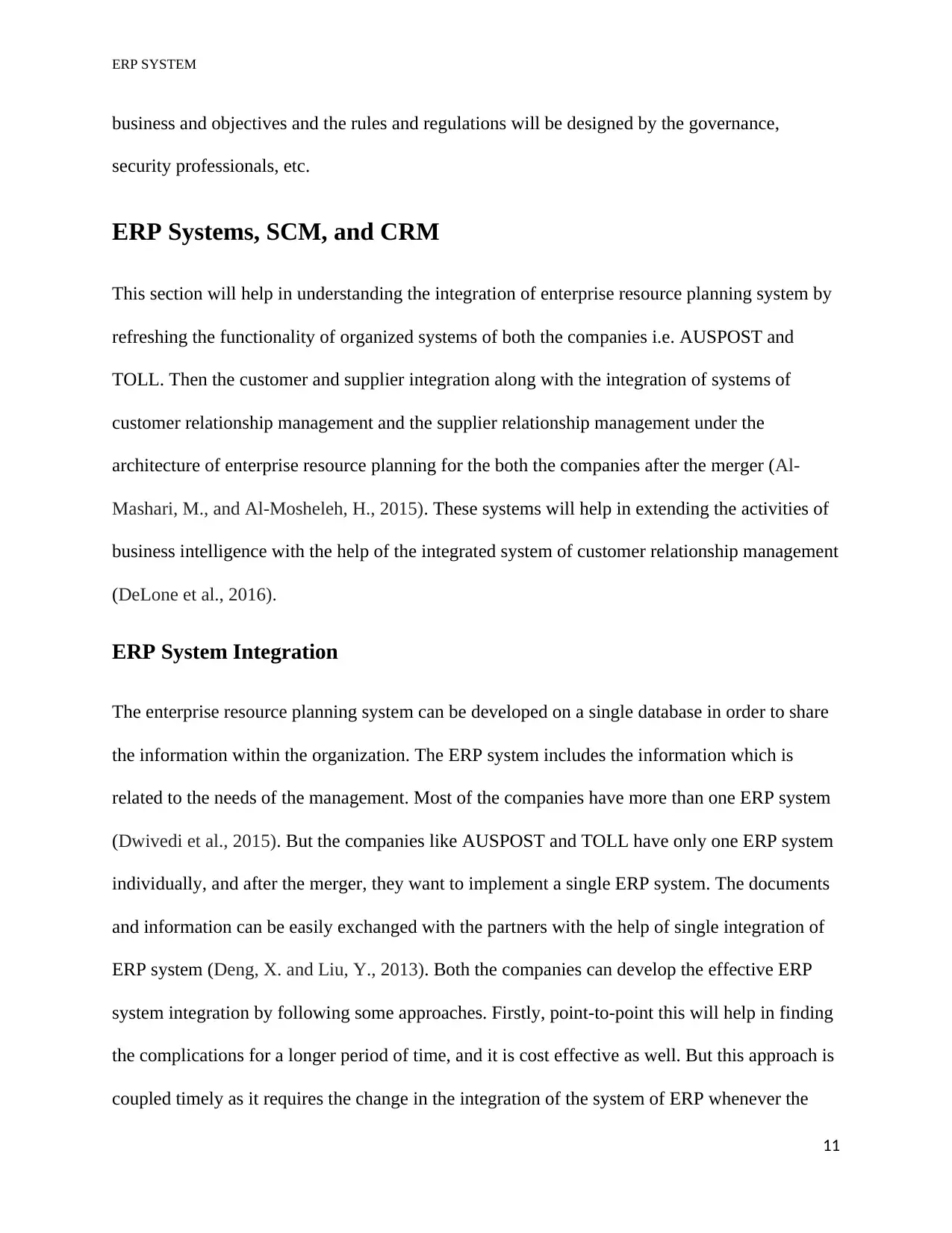
ERP SYSTEM
business and objectives and the rules and regulations will be designed by the governance,
security professionals, etc.
ERP Systems, SCM, and CRM
This section will help in understanding the integration of enterprise resource planning system by
refreshing the functionality of organized systems of both the companies i.e. AUSPOST and
TOLL. Then the customer and supplier integration along with the integration of systems of
customer relationship management and the supplier relationship management under the
architecture of enterprise resource planning for the both the companies after the merger (Al-
Mashari, M., and Al-Mosheleh, H., 2015). These systems will help in extending the activities of
business intelligence with the help of the integrated system of customer relationship management
(DeLone et al., 2016).
ERP System Integration
The enterprise resource planning system can be developed on a single database in order to share
the information within the organization. The ERP system includes the information which is
related to the needs of the management. Most of the companies have more than one ERP system
(Dwivedi et al., 2015). But the companies like AUSPOST and TOLL have only one ERP system
individually, and after the merger, they want to implement a single ERP system. The documents
and information can be easily exchanged with the partners with the help of single integration of
ERP system (Deng, X. and Liu, Y., 2013). Both the companies can develop the effective ERP
system integration by following some approaches. Firstly, point-to-point this will help in finding
the complications for a longer period of time, and it is cost effective as well. But this approach is
coupled timely as it requires the change in the integration of the system of ERP whenever the
11
business and objectives and the rules and regulations will be designed by the governance,
security professionals, etc.
ERP Systems, SCM, and CRM
This section will help in understanding the integration of enterprise resource planning system by
refreshing the functionality of organized systems of both the companies i.e. AUSPOST and
TOLL. Then the customer and supplier integration along with the integration of systems of
customer relationship management and the supplier relationship management under the
architecture of enterprise resource planning for the both the companies after the merger (Al-
Mashari, M., and Al-Mosheleh, H., 2015). These systems will help in extending the activities of
business intelligence with the help of the integrated system of customer relationship management
(DeLone et al., 2016).
ERP System Integration
The enterprise resource planning system can be developed on a single database in order to share
the information within the organization. The ERP system includes the information which is
related to the needs of the management. Most of the companies have more than one ERP system
(Dwivedi et al., 2015). But the companies like AUSPOST and TOLL have only one ERP system
individually, and after the merger, they want to implement a single ERP system. The documents
and information can be easily exchanged with the partners with the help of single integration of
ERP system (Deng, X. and Liu, Y., 2013). Both the companies can develop the effective ERP
system integration by following some approaches. Firstly, point-to-point this will help in finding
the complications for a longer period of time, and it is cost effective as well. But this approach is
coupled timely as it requires the change in the integration of the system of ERP whenever the
11
⊘ This is a preview!⊘
Do you want full access?
Subscribe today to unlock all pages.

Trusted by 1+ million students worldwide
1 out of 29